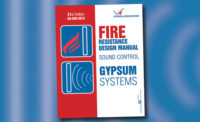Preview of the New Plaster Manual
Hard Work and Toil










It has been 25 years since the Drywall and Plaster Systems Manual was last released. It has been an icon in the wall and ceiling industry for decades, but sorely in need of updating. With three revisions, and so many recent changes in our industry, it was time for a completely new manual. After years of compiling data, research, interviews and real-life experiences, the new manual is ready.
Manual History
The first edition of the manual has its roots dating back to 1957. It was then the California Lathing and Plastering Contractors Association that began publishing industry recognized specifications and recommendations to the plaster industry.
Twenty five years later the new replacement manual is coming out. It has a new name, new look, completely updated and revised.
Changes
We are all aware of sweeping changes in our industry, and the manual reflects those changes as it welcomes consultants as an important part of the fabric of today and tomorrows design, construction and quality control process. The new manual will help them better understand plaster and drywall. The changes include increased energy efficiency, LEED, air barriers, a wider variety of interior and exterior lath and plaster products. The drywall industry has changed too. Today we see more and more radius walls and smooth wall is used on almost every project. While the new manual is less focused on interior lath and plaster, it has greatly expanded coverage of exterior stucco. The new manual also provides assistance with Venetian, decorative plaster and continuous insulation plaster. Drywall is covered with comprehensive explanation to product selection, special conditions, installation, joint treatment and finishing. Pre-meeting agenda recommendations, judging and troubleshooting make this a complete manual.
Generic
The Drywall and Plaster Assemblies Manual is primarily focused on “generic” construction. Intended to mesh with the code and referenced standards, it is written to be as generic as possible. DPAM is equally not intended to limit the use of or dissuade designers from specifying proprietary systems. The information contained in this manual is from the resource libraries of the TSIB and WWCCA that date as far back as the 1920’s and been reviewed by a committee of experts their respective fields. Supervisors for contractors, architects, code inspectors, lawyers and even construction defect experts have all contributed. History helps paint a picture of how we got to where we are today. Although weepscreed did not have a name at the time, it was developed as a collaboration in 1952 between the architects, Federal Housing Authority and the California Lath and Plaster Contractors Association. Ironically, as the industry has changed dramatically since 1952, the drawing is virtually the same as today’s weep screed.
Looking Toward the Future
The new manual will be integrated with an online Web site for access and allow for updates and innovation as needed. Besides helping explain how plaster and drywall work, the manual provides options to the code, enhance established standards and tries to clarify confusion. DPAM is meant to provide viable options to designers, contractors and support code officials.
Covering the history of lath, plaster and drywall is great, but there is an eye to the future as well. Construction has become very complicated and expensive. The need for skilled persons and team work to make projects come in on time and on budget cannot be overstated. In today’s more litigious society, the manual is an effort to assist the designers with options and open the world of the “alternative” solutions to design issues. The contractor is equally afforded some latitude on what is best practice and assist with caveats on issues that could present problems for the team. The Building Department or authority having jurisdiction has the daunting task to decide what alternatives they should accept. The DPAM will assist them in making an informed decision based on neutral third party experts with vast experience in those areas.
Providing Options
Providing options will open up healthy dialogue to discuss which method is preferred for every unique situation. This fits nicely into today’s more complex construction designs and practices.
The manual provides generic cement plaster specifications written by experts in lath and plaster that are constructible, code compliant and provide value for the building owner. The assemblies section offers a variety of options including open stud, sheathed walls, solid mass walls and even various Continuous Insulation assemblies with details using cement plaster. Fire and STC ratings accompany most assemblies to provide the architect a one stop shop manual. The manual will be a reference manual for architects, designers, contractors, consultants and agencies having jurisdictional authority over plaster or drywall. Chapters are laid out for easy research of specific items. The newest manual is just another link in a long line of successful impacts made on the wall and ceiling industry.
Those Extras
There are lots of extra items in the manual to help designers, contractors and consultants.
- A chapter devoted to plaster finishes, the pictorial selection of cement plaster and acrylic textures will allow designers to assist owners with selection of a texture. An industry recognized name used to reference each texture and a brief explanation on application procedures.
- A comprehensive list of industry standards compiled for easy reference and cross reference.
- More than 250 industry definitions related to wall and ceiling work.
- Covers a variety of concepts and troubleshooting issues.
- A procedure to make a seamless metal head flashing.
- Compare and contrasts acrylic finish versus cement finish.
- EIFS and one-coat stucco.
- Decorative foam shapes.
- Types of laths, with recommendations for selection.
- Water management principles of cement plaster assemblies.
The manual is being produced by W&C’s custom publishing division orangetap. Contact the magazine’s staff for more information on this publication and release dates.
Looking for a reprint of this article?
From high-res PDFs to custom plaques, order your copy today!










